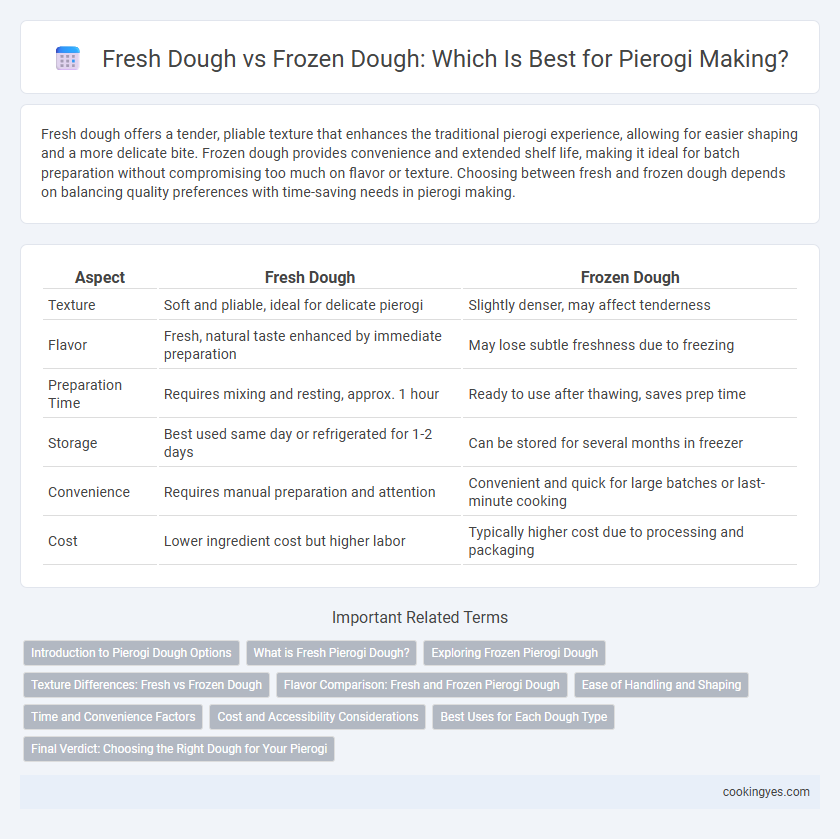Fresh dough offers a tender, pliable texture that enhances the traditional pierogi experience, allowing for easier shaping and a more delicate bite. Frozen dough provides convenience and extended shelf life, making it ideal for batch preparation without compromising too much on flavor or texture. Choosing between fresh and frozen dough depends on balancing quality preferences with time-saving needs in pierogi making.
Table of Comparison
| Aspect | Fresh Dough | Frozen Dough |
|---|---|---|
| Texture | Soft and pliable, ideal for delicate pierogi | Slightly denser, may affect tenderness |
| Flavor | Fresh, natural taste enhanced by immediate preparation | May lose subtle freshness due to freezing |
| Preparation Time | Requires mixing and resting, approx. 1 hour | Ready to use after thawing, saves prep time |
| Storage | Best used same day or refrigerated for 1-2 days | Can be stored for several months in freezer |
| Convenience | Requires manual preparation and attention | Convenient and quick for large batches or last-minute cooking |
| Cost | Lower ingredient cost but higher labor | Typically higher cost due to processing and packaging |
Introduction to Pierogi Dough Options
Fresh dough for pierogi offers a tender texture and quicker preparation, enhancing the traditional flavor and pliability essential for authentic Polish cuisine. Frozen dough provides convenience and extended shelf life, allowing for easy storage and batch preparation without sacrificing much in taste or quality. Choosing between fresh and frozen dough depends on the balance of time efficiency and desired texture in pierogi-making.
What is Fresh Pierogi Dough?
Fresh pierogi dough is made from basic ingredients such as flour, water, eggs, and salt, mixed and rolled out immediately before shaping and filling pierogi. This dough offers a tender, elastic texture that results in a delicate, soft bite after cooking, preserving the traditional homemade flavor and pliability. Fresh dough requires prompt preparation and use, contrasting with frozen dough, which is pre-made and stored for convenience but may alter the texture and taste slightly upon cooking.
Exploring Frozen Pierogi Dough
Frozen pierogi dough offers convenience and consistent texture, making it a popular choice for both home cooks and professional chefs. It retains moisture and elasticity through special preservation techniques, allowing for easy handling and efficient production without sacrificing quality. Using frozen dough can significantly reduce preparation time while ensuring reliable results in pierogi making.
Texture Differences: Fresh vs Frozen Dough
Fresh dough for pierogi yields a tender, pliable texture that allows for easy shaping and a delicate bite after cooking. Frozen dough tends to develop a firmer, sometimes slightly tougher texture due to moisture loss and ice crystal formation during freezing. The choice between fresh and frozen dough significantly impacts the final pierogi texture, influencing mouthfeel and overall eating experience.
Flavor Comparison: Fresh and Frozen Pierogi Dough
Fresh pierogi dough offers a tender texture and rich, natural flavor due to its immediate preparation and minimal processing, enhancing the overall taste of the pierogi. Frozen pierogi dough may experience slight flavor dilution and textural changes caused by ice crystal formation during freezing and thawing. However, freezing preserves dough freshness over time, providing convenience without significantly compromising the classic pierogi flavor profile.
Ease of Handling and Shaping
Fresh dough for pierogi offers superior pliability and elasticity, making it easier to roll out evenly and shape into consistent dumplings. Frozen dough tends to be stiffer and may require thawing and additional kneading to regain its original texture, which can slow down the preparation process. Choosing fresh dough enhances control during handling, resulting in perfectly shaped pierogi with minimal effort.
Time and Convenience Factors
Using fresh dough for pierogi ensures a tender texture and authentic flavor but requires more preparation time, including mixing, kneading, and resting. Frozen dough offers convenience by saving time on preparation and can be stored for extended periods, though it may slightly affect the dough's elasticity and final consistency. For busy home cooks or large batches, frozen dough streamlines the process, while fresh dough is preferred for traditional, artisanal quality.
Cost and Accessibility Considerations
Fresh dough for pierogi typically offers superior texture and flavor but requires immediate use and consistent ingredient availability, potentially increasing costs for small-scale or home cooks. Frozen dough provides extended shelf life and convenience, reducing waste and allowing bulk preparation, which can lower overall expenses, especially for commercial operations. Accessibility to quality ingredients and proper freezing equipment plays a crucial role in determining the most cost-effective option for pierogi production.
Best Uses for Each Dough Type
Fresh dough for pierogi offers a tender texture and pliability ideal for delicate fillings like cheese or potato, ensuring a soft bite after boiling. Frozen dough provides convenience and structure, making it suitable for hearty or meat-based pierogi that benefit from a firmer exterior during frying or baking. Choosing fresh dough optimizes softness and flavor, while frozen dough supports durability and ease for batch preparation and storage.
Final Verdict: Choosing the Right Dough for Your Pierogi
Fresh dough offers superior elasticity and tenderness, resulting in pierogi with a delicate, melt-in-your-mouth texture. Frozen dough provides convenience and extended shelf life but may compromise softness and require longer thawing times to achieve optimal pliability. For authentic pierogi with exceptional flavor and texture, fresh dough remains the preferred choice among chefs and home cooks.
Fresh Dough vs Frozen Dough for Pierogi making Infographic

 cookingyes.com
cookingyes.com